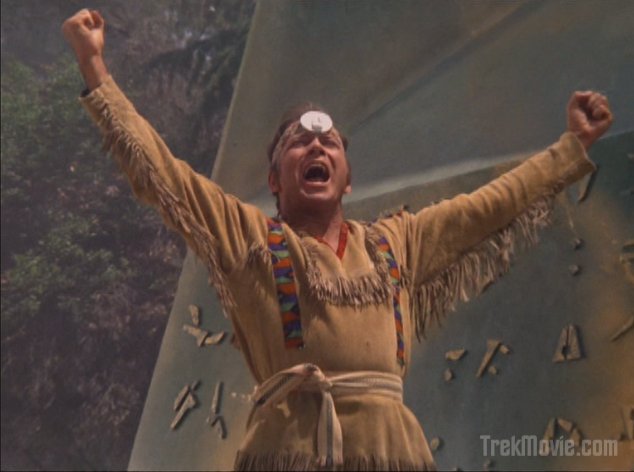Case Study: “The Paradise Syndrome” (1968)
Despite the Kellam report, the aired version of “The Paradise Syndrome” reproduces the noble savage stereotype with little change. The episode begins with Kirk, Spock, and McCoy beaming down to a planet that lies directly in the path of a huge asteroid—an ominous collision that will ultimately kill all the planet’s inhabitants, “a mixture of Navajo, Mohican, and Delaware,” Spock describes. Upon seeing the Indians, Kirk fantasizes about their “peaceful, uncomplicated” nature, and Dr. McCoy chimes in: “Typical human reaction to an idyllic natural setting. Back in the twentieth century we referred to it as the Tahiti syndrome. It’s particularly common to over-pressured leader-types like starship captains.” Soon after the landing party finds evidence of the conscientious super-race who “preserved” the Indians—the Noahs the galaxy, as it were—Kirk accidentally hits his head, gets amnesia, and is subsequently separated from his friends. After diligently trying but failing to rescue their captain, Spock and McCoy return to the Enterprise to deal with diverting the asteroid. Back on the planet, the captain, unaware that he is a “more evolved” human than the Indians, befriends the tribe, eventually “rising to the top” apparently due to his “natural” ability by becoming a medicine chief and, as the paradise syndrome would have it, marrying—in a feathered cloak no less!—the beautiful Miramanee (Sabrina Scharf).
As in the production documents, the noble savage stereotype in the broadcast text emphasizes the “superiority” of whiteness. In one scene, for example, Miramanee cannot figure out how to pull Kirk’s shirt off, s she cannot find any lacing. She is portrayed as simpleminded, not that bright. This is not the case with Kirk. Moments before, he had fashioned a lamp from an old piece of pottery and saved a boy by using mouth-to-mouth resuscitation. Despite his amnesia, he is shown as naturally superior. The text seems to say: while you can take the white man out of civilization, you can’t take civilization out of the white man. Given the impossibility of the white man’s return to the simplicity of paradise, the ending in particular plays out the morality of whiteness and, in the process, resolves Kirk’s Tahiti syndrome. When the Indians realize Kirk is not a god, they stone both him and Miramanee (it’s the Indians who are violent in this version of the noble savage stereotype). Spock and McCoy eventually intervene, but only Kirk survives. In this take on a standard white/red miscegenation narrative, the native girl dies so that Kirk, the white male hero, isn’t shown unheroically and immorally leaving her and their unborn baby behind. In accordance with both the network censor’s goal and Roddenberry’s vision of paradise, the starship captain is left unencumbered in his trek toward a white future.


5 comments:
Writerfella here --
If all of the images shown in the post were current to 2008, they might be a lot more meaningful than was represented. But as with any historical perspective, they only appear cogent to this time and place.
And Kellam DeForrest only was an advisory reference resource, NEVER a controller. The agency only could make recommendations and time constraints ordinarily did not allow for ALL of the script change recommendations to be implemented. They corrected "How Sharper Than A Serpent's Tooth" one time: "Change 'ungrateful' to 'thankless' in the KING LEAR line quote."
All Best
Russ Bates
'writerfella
As usual, I don't know what you're talking about. All the images in my Paradise Syndrome postings came from The Paradise Syndrome. What other images are relevant to a discussion of The Paradise Syndrome?
Since Kellam DeForest was only an advisory "resource," we can blame Roddenberry for failing to implement its suggestions. Many of them were a matter of individual words. They would've taken only minutes to change.
As for the larger script suggestions that would've required new shooting plans, we can again blame Roddenberry. He commissioned a stereotype-ridden script based on a stereotypical premise. If Kellam DeForest's recommendations surprised him, he had no business producing a script about Indians.
Whoever posted this has no idea what he is talking about. The stereotype argument makes no sense. Kirk is not smarter because he is white, but because he comes from an advanced planet with knowledge not yet discovered by this civilization.
The issue with his shirt is an example of her intelligence not her lack there of. She quickly notices what appears to be a flaw in the design.
And here I thought it was all about how beautiful Indian girls are, and deflecting an asteroid hehe.
Come on people, I've watched this episode several times over the years and never thought prejudice was entertained in any Star Trek episodes. In fact it seemed to me in many of them that prejudice of any kind was frowned upon. Also i never thought miramanee was not intelligent. Many beautiful white women are Airheads. I just don't see the argument here.
Post a Comment